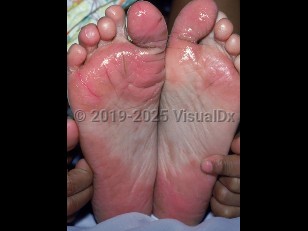Immersion foot
Alerts and Notices
Important News & Links
Synopsis

Historically known as "trench foot," immersion foot is cold-weather foot damage caused by prolonged exposure to cold water producing an inflammatory response, such as in trench warfare during World War I. With extended exposure to the cold, the lower extremity vasculature remains constricted to the point of tissue and nerve ischemia. The undomiciled population is most commonly affected today.
Also referred to as nonfreezing cold injury, immersion foot is commonly seen in undomiciled individuals who are exposed to wet footwear and socks in cold weather, resulting in numb, swollen, pale, and clammy feet, which may lead to tissue damage and infection. Long-term disturbance of autonomic function is not uncommon and may manifest as increased pain, sweating, and temperature sensitivity.
Cases have occurred in children following prolonged use of plaster casts and hip spica casts that remain damp from sweat for extended periods of time. Additionally, mismanagement of erythromelalgia has led to immersion foot when there has been excessive use of extreme cooling measures, such as fans, ice, and cold water, for an extended duration of time.
Management includes the drying and gradual rewarming of feet, nonsteroidal anti-inflammatory pain medications (NSAIDs), treatment of infections, and avoiding recurrence. Treatment of autonomic dysfunction is supportive.
Also referred to as nonfreezing cold injury, immersion foot is commonly seen in undomiciled individuals who are exposed to wet footwear and socks in cold weather, resulting in numb, swollen, pale, and clammy feet, which may lead to tissue damage and infection. Long-term disturbance of autonomic function is not uncommon and may manifest as increased pain, sweating, and temperature sensitivity.
Cases have occurred in children following prolonged use of plaster casts and hip spica casts that remain damp from sweat for extended periods of time. Additionally, mismanagement of erythromelalgia has led to immersion foot when there has been excessive use of extreme cooling measures, such as fans, ice, and cold water, for an extended duration of time.
Management includes the drying and gradual rewarming of feet, nonsteroidal anti-inflammatory pain medications (NSAIDs), treatment of infections, and avoiding recurrence. Treatment of autonomic dysfunction is supportive.
Codes
ICD10CM:
T69.029A – Immersion foot, unspecified foot, initial encounter
SNOMEDCT:
271331002 – Immersion foot
T69.029A – Immersion foot, unspecified foot, initial encounter
SNOMEDCT:
271331002 – Immersion foot
Look For
Subscription Required
Diagnostic Pearls
Subscription Required
Differential Diagnosis & Pitfalls

To perform a comparison, select diagnoses from the classic differential
Subscription Required
Best Tests
Subscription Required
Management Pearls
Subscription Required
Therapy
Subscription Required
References
Subscription Required
Last Reviewed:01/31/2019
Last Updated:06/17/2021
Last Updated:06/17/2021
Immersion foot

